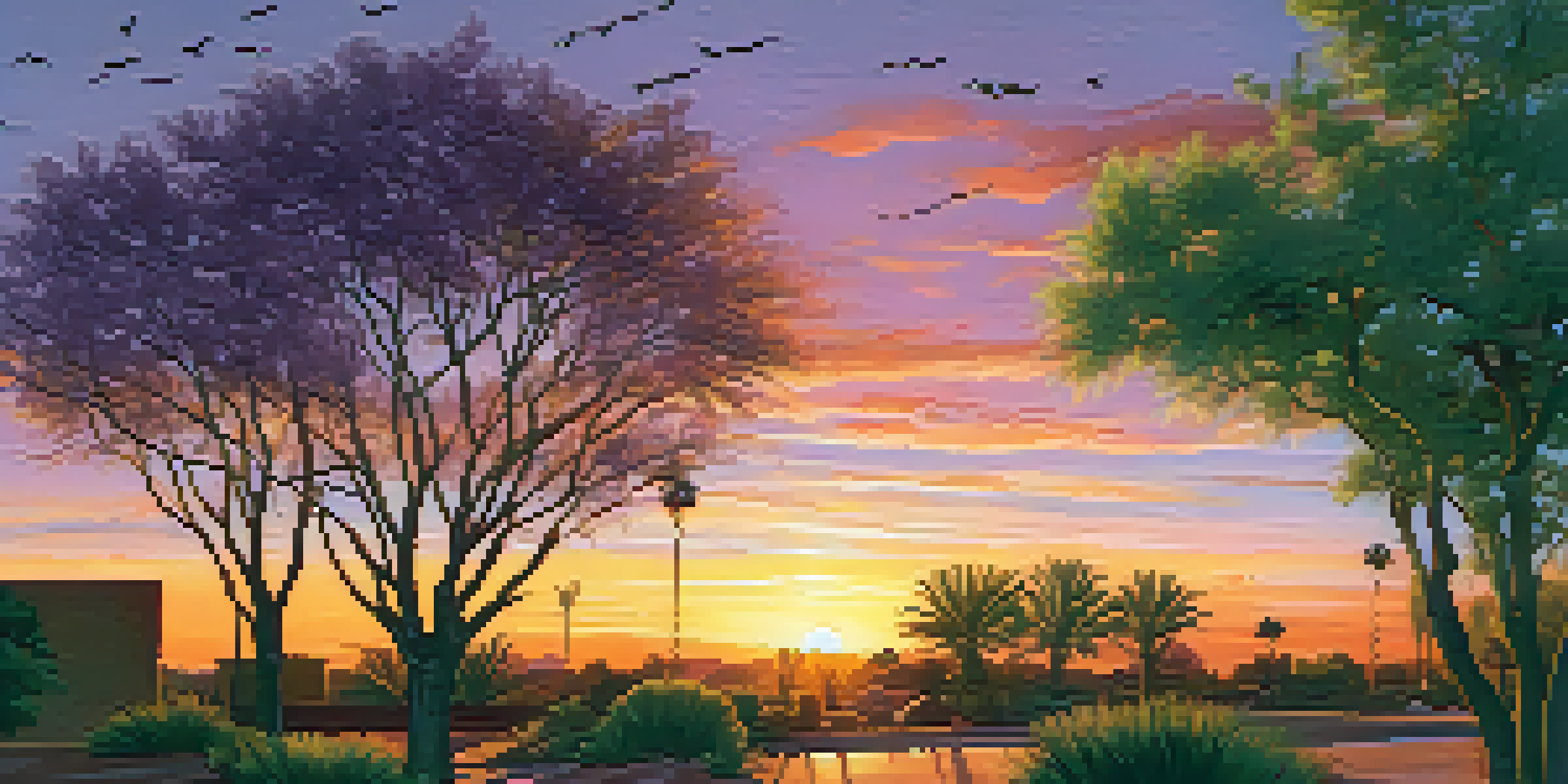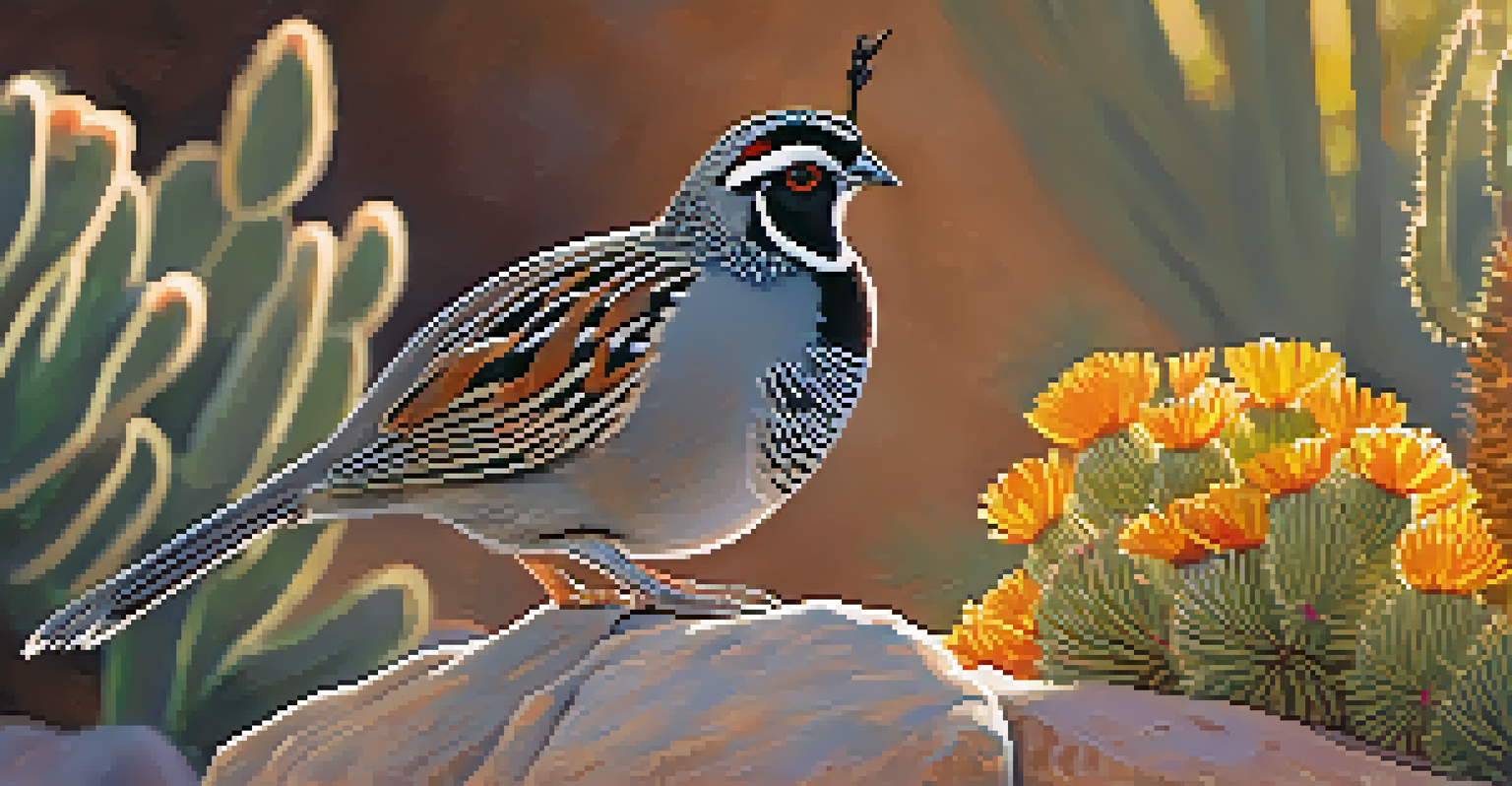Phoenix's Urban Wildlife: A Diverse Ecosystem in the City

An Overview of Phoenix's Unique Urban Ecosystem
Phoenix is not just a bustling metropolis; it’s a thriving urban ecosystem. The city's climate and geography create a unique habitat where wildlife can flourish alongside human activity. From the Sonoran Desert's diverse flora to the urban parks, Phoenix supports a remarkable variety of species that often go unnoticed.
In every walk with nature one receives far more than he seeks.
Many residents might be surprised to learn that urban wildlife contributes significantly to the ecological balance of the area. Birds, mammals, reptiles, and insects all play vital roles, helping to pollinate plants and control pests. This intricate web of life exists right in our backyards and city parks, reminding us of nature's resilience.
Understanding this ecosystem is crucial for urban dwellers. It encourages a sense of responsibility toward preserving wildlife habitats and maintaining biodiversity, even in a city setting. By becoming aware of the wildlife around us, we can foster a greater appreciation for the natural world.
Common Wildlife Species Found in Phoenix
Phoenix is home to a variety of wildlife species that adapt well to urban environments. Some of the most common residents include coyotes, rabbits, and a wide range of bird species, like the Gambel's quail and the cactus wren. These creatures have learned to navigate city life while maintaining their natural behaviors.

For example, coyotes have become adept at foraging for food in suburban areas, often seen trotting through neighborhoods during dawn or dusk. Their presence serves as a reminder of the wildness that coexists within our city limits. Similarly, the vibrant birdlife adds a splash of color and song to our urban landscape.
Phoenix's Urban Wildlife Diversity
The city hosts a remarkable variety of wildlife species that thrive in urban environments, contributing to the ecological balance.
Many people enjoy birdwatching or simply observing these animals in their natural habitats. Parks and green spaces throughout the city provide excellent opportunities for residents to connect with this wildlife, fostering a sense of community and shared stewardship.
The Role of Urban Parks in Supporting Wildlife
Urban parks play a pivotal role in sustaining wildlife populations in Phoenix. These green spaces act as vital habitats, offering food and shelter for various species amidst the concrete jungle. Parks like South Mountain Park and the Phoenix Zoo provide essential ecosystems for both local and migratory wildlife.
The future will be green, or not at all.
Moreover, these parks serve as educational platforms, helping residents learn about the importance of conservation. Programs and events hosted by local organizations often focus on wildlife observation and habitat preservation, encouraging community involvement. Such initiatives foster a connection between people and nature.
By visiting these parks, residents can witness firsthand the interactions between wildlife and their environment. Whether it's spotting a hawk soaring above or a family of rabbits munching on grass, these experiences deepen our appreciation for the diverse ecosystems right in our backyards.
Conservation Efforts for Urban Wildlife in Phoenix
Conservation initiatives in Phoenix are crucial for protecting urban wildlife and their habitats. Various organizations work tirelessly to promote awareness and implement strategies aimed at preserving these ecosystems. Efforts include habitat restoration, wildlife corridors, and educational programs to engage the community.
One notable example is the Phoenix Audubon Society, which focuses on bird conservation and habitat protection. Their initiatives help support local bird populations and promote sustainable practices among residents. By fostering a culture of conservation, we can ensure that future generations will appreciate the urban wildlife we enjoy today.
Importance of Urban Parks
Urban parks serve as vital habitats for wildlife, offering essential resources while also educating residents about conservation.
In addition, collaboration between local government and wildlife organizations strengthens these efforts. By investing in green infrastructure and habitat conservation, Phoenix can continue to be a haven for wildlife amidst urban growth. Every action counts in maintaining the delicate balance between city life and nature.
Challenges Facing Urban Wildlife in Phoenix
Despite the vibrant ecosystem, urban wildlife in Phoenix faces several challenges. Habitat loss due to urbanization is one of the most significant threats, as natural landscapes are replaced with buildings and roads. This encroachment limits the space available for wildlife to thrive and find food.
Additionally, pollution and human activity can disrupt the delicate balance of these ecosystems. Pesticides, litter, and noise can negatively impact wildlife health and behavior. Understanding these challenges is critical for residents, as it highlights the importance of responsible living and environmental stewardship.
However, awareness and proactive measures can help mitigate these issues. By supporting local conservation efforts and practicing eco-friendly habits, individuals can play a role in protecting urban wildlife. Every small change contributes to creating a more sustainable environment for all species.
How Residents Can Support Urban Wildlife
Residents can take various steps to support urban wildlife in Phoenix and promote biodiversity. Simple actions like planting native plants in gardens can provide essential food and shelter for local species. Native plants are well-suited for the local environment and require less water, making them a sustainable choice.
Moreover, creating wildlife-friendly spaces, like bird feeders or native plant gardens, encourages animals to visit and thrive. Even small changes, such as reducing outdoor lighting, can significantly impact nocturnal wildlife. By making these adjustments, residents help maintain the natural rhythms of urban ecosystems.
Challenges and Conservation Efforts
Urban wildlife faces significant challenges due to habitat loss and pollution, making conservation initiatives crucial for their survival.
Engaging with local wildlife groups and participating in community events can also bolster conservation efforts. Whether it’s a clean-up event or a birdwatching workshop, involvement fosters a sense of community and shared responsibility. Together, we can create a welcoming environment for the diverse wildlife that shares our city.
The Future of Urban Wildlife in Phoenix
Looking ahead, the future of urban wildlife in Phoenix depends on continued awareness and proactive conservation efforts. As the city grows, it's essential to prioritize sustainable development that considers the needs of local wildlife. This balance will ensure that both nature and urban life can coexist harmoniously.
Innovative strategies, such as creating wildlife corridors and expanding green spaces, can significantly enhance habitat connectivity. These initiatives will not only benefit wildlife but also improve the quality of life for residents, providing more opportunities for outdoor activities and connection to nature.

Ultimately, fostering a culture of respect and stewardship toward urban ecosystems will be key. By educating ourselves and advocating for wildlife-friendly practices, we can ensure that Phoenix remains a vibrant city where nature and urban life flourish side by side.